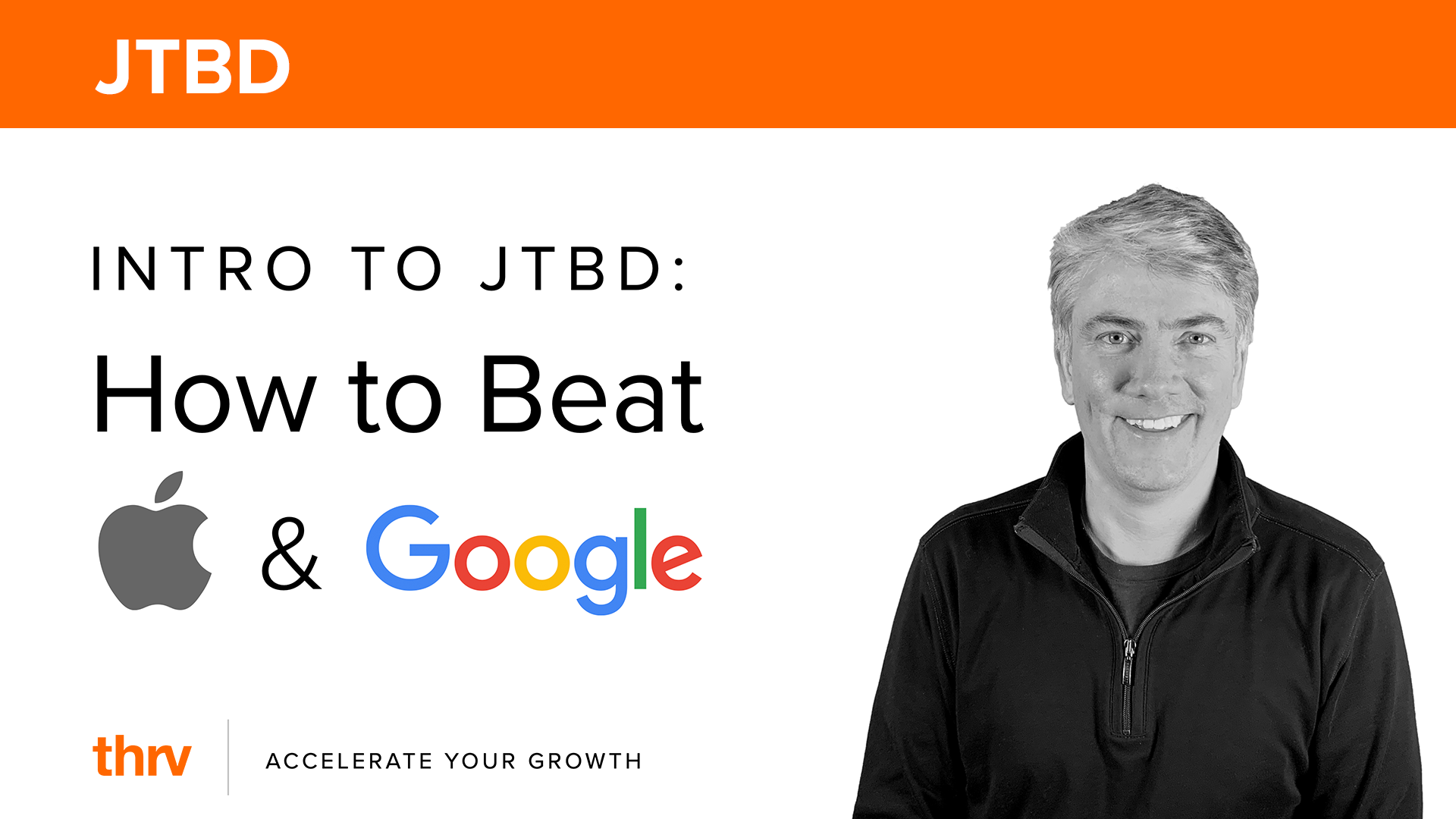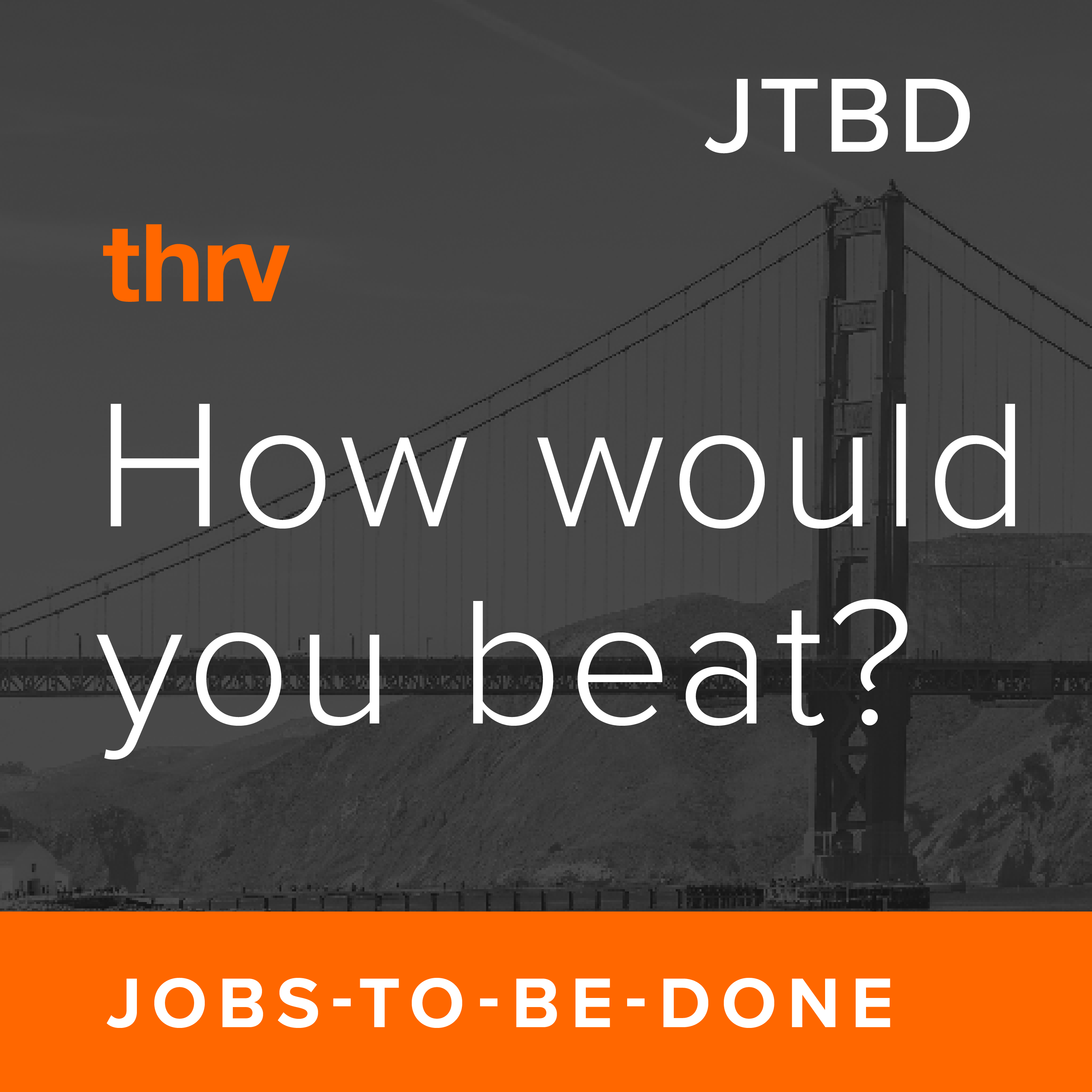How to Identify Your Real Market: A Google Maps Example
![]()
In 2011, IBM found that drivers in cities around the world spend an average of 20 minutes finding a parking spot. Such studies highlight the need for more efficient parking.
Entrepreneurs and companies have been taking steps to solve the parking problem for some time now. There are many parking apps out there, yet no clear winner. It's still extraordinarily difficult to park in major cities. Drivers are frustrated. Any company that can make it fast and easy to find a parking spot is likely to grow very fast.
So, it's no surprise that the world's second-largest company by market cap, Alphabet (aka Google), has joined the game. Google has introduced a parking difficulty function to Google Maps, allowing drivers to see if parking availability in a specific area is limited, medium, or easy.
The parking difficulty icon is certainly a cool function on its own, but it's part of a much larger goal. To understand this larger goal, let's consider the parking difficulty function through the lens of the Jobs-to-be-Done Theory, which was popularized by Clay Christensen of Harvard Business School. Christensen says, "customers aren't buying your product, they are hiring it to get a job done."
What job would someone hire the parking icon to get done? Well, it helps drivers park a vehicle. But, why does anyone need to park a vehicle? Unless you're a valet or you live in a city with street cleaners requiring alternate side parking rules, you don't wake up in the morning thinking, "Gee, I have to park my car today!" The reason you park a vehicle is so you can go to your destination. So "park a vehicle" is a job step in this larger job: reach a destination on time.
With Google now making moves to address problems with parking, what can car-parking apps like SpotHero and Luxe do to stay successful? After all, if Google gets this job step done along with many of the other steps in the job, it won't be long before people stop using SpotHero and Luxe for parking because Google is getting the whole job done for them.
Jobs Theory helps us see options for services like SpotHero and Luxe to stay alive.
Calculate the Competitive Landscape
Using Jobs Theory, we can define the market based on the customer's job-to-be-done, which is "reach a destination on time." Reaching a destination on time is a functional job, meaning that it is a key goal or task that people need to accomplish in their personal or professional lives. The market for the job of reaching a destination on time exists because many people need to execute this functional job frequently. The company that gets this job done better for customers will win the market.
We also know that "park the vehicle" is just one of the job steps in the job of getting to a destination on time. At thrv, we've identified 16 total steps in for the job of drivers reaching a destination on time:
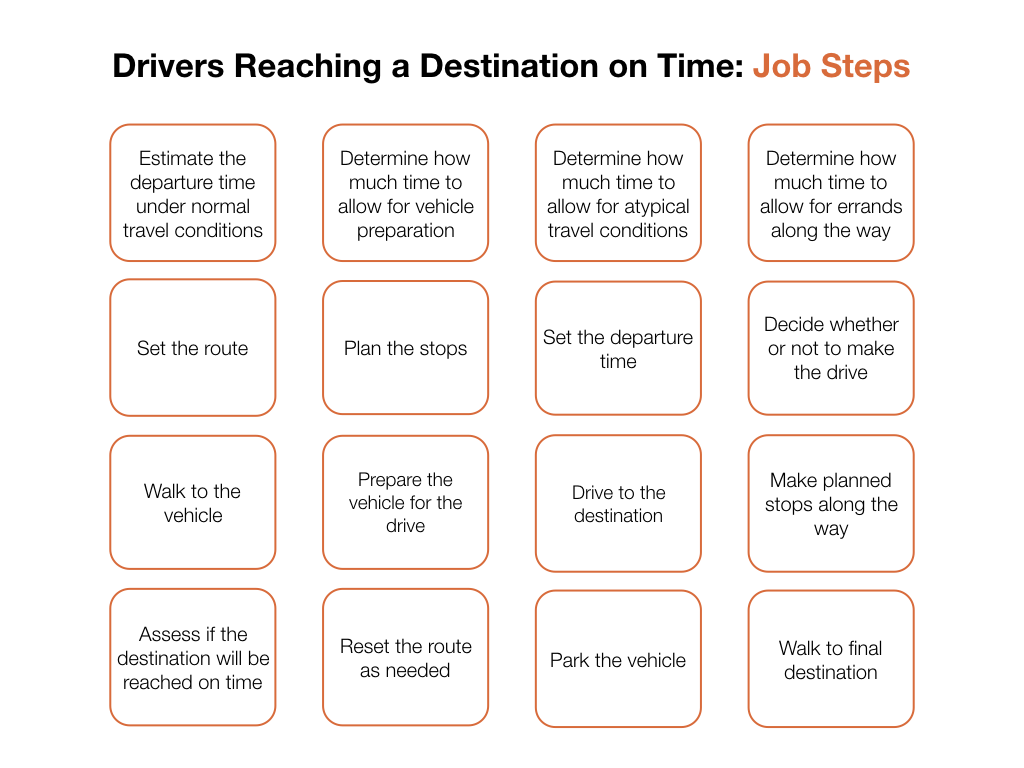
Companies like SpotHero and Luxe complete the job step of parking the vehicle for the customer, but remember that customers must get the whole job done (reach the destination on time). This means companies fulfilling the job step of parking the vehicle aren't just in competition with each other, but also with any service that gets any other steps in the job done, which means parking apps have more to worry about than each other.
Obviously, this broadens the competitive landscape. It's crucial for companies like SpotHero and Luxe to see and address this risk. Because bigger companies that are fulfilling other job steps may come in and start fulfilling their job step as well (i.e. Google), which could put them out of business.
There are many other big companies doing other job steps. For instance, Uber helps get the following steps done:

Even Tesla's self-driving cars are competition for parking apps. Not only do these driverless cars handle steps like setting the route and planning the stops, they also self-park! If driverless car makers also figure out how to get autonomous vehicles to find open spots, no one will need to use other apps.
How Google Maps Extended Their Lead
The overall leader in the market of reaching a destination on time is Google, with Uber and Tesla making strides. Any one of these tech giants, and others like Apple and Lyft, present a threat to parking apps.
With Maps, one of the world's most used apps, Google is already tackling other steps in the job of reaching a destination on time, such as:

Now that Maps serves needs within the parking job step, like reducing the time it takes to find a parking spot close to the final destination, the tech giant has extended its lead. Also, in addition to Maps, you also have things like Google Now and self-driving cars. All of these are working together to help Google do more job steps for reaching a destination on time.
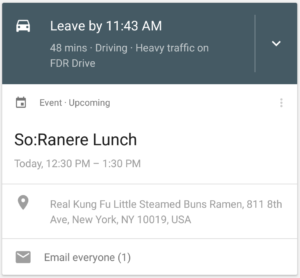
For example, the Google Search App (formerly Google Now) addresses needs in these job steps:

And Waymo, Google's self-driving car, eliminates at least these three steps:

Considering everything Google is doing to complete the job of a reaching a destination on time, it's clear the company has a lead. The launch of its parking difficulty icon puts them even further ahead of competitors. No other solution completes the job better than Google's overall ecosystem.
Ask The Right Questions
There are a host of parking apps in the market, and some do complete this job step quite well. For instance, BestParking helps drivers park a vehicle quickly by locating the most convenient garages, and Parker helps drivers find paid parking and navigate street parking rules.
But while parking apps may do their job step well, they need to be aware that giants like Google are competitive threats, as they are already completing many of the steps for getting to a destination on time.
This should be concerning for parking app developers. If drivers can set the route, plan stops, assess if the destination can be reached on time, and find a parking spot all within one app (Google Maps), why would they open up another app just for parking?
To safeguard against a company like Google taking away your customers, smaller companies need to be asking themselves the right questions as they build their solutions. These include:
Are you working on a job step that much bigger companies will target soon because they're already fulfilling other steps in the job?
If so, what does the larger company fail to do well?
Answering the first question involves employing JTBD Theory to see all the jobs steps within a job. Again, parking is one step to completing the job of reaching a destination on time.
Once you know about the potential competitive threat to your job step, you can make plans to protect yourself. This necessitates first improving upon the existing job step you complete, and then attempting to fulfill other jobs steps (especially those competitors don't do well).
Improve and Expand on the Existing Job Step
The first solution parking apps have is to improve on what they already help customers do: Park the vehicle. If they are able to do this ten times better than Google, then users most likely won't abandon the app.
The key to doing this lies in recognizing and solving customer needs. If you don't define and identify these customer needs, then you are guessing about what they want. A customer need is a metric customers use to judge how quickly and accurately they can execute a job-to-be-done. For reaching a destination on time, there are lots of needs that must be satisfied.
For instance, let's look at job step 15, "park the vehicle." For this step, we've identified 11 needs. Satisfying more needs for this parking job step will help parking apps grow profits with less risk. These needs are:
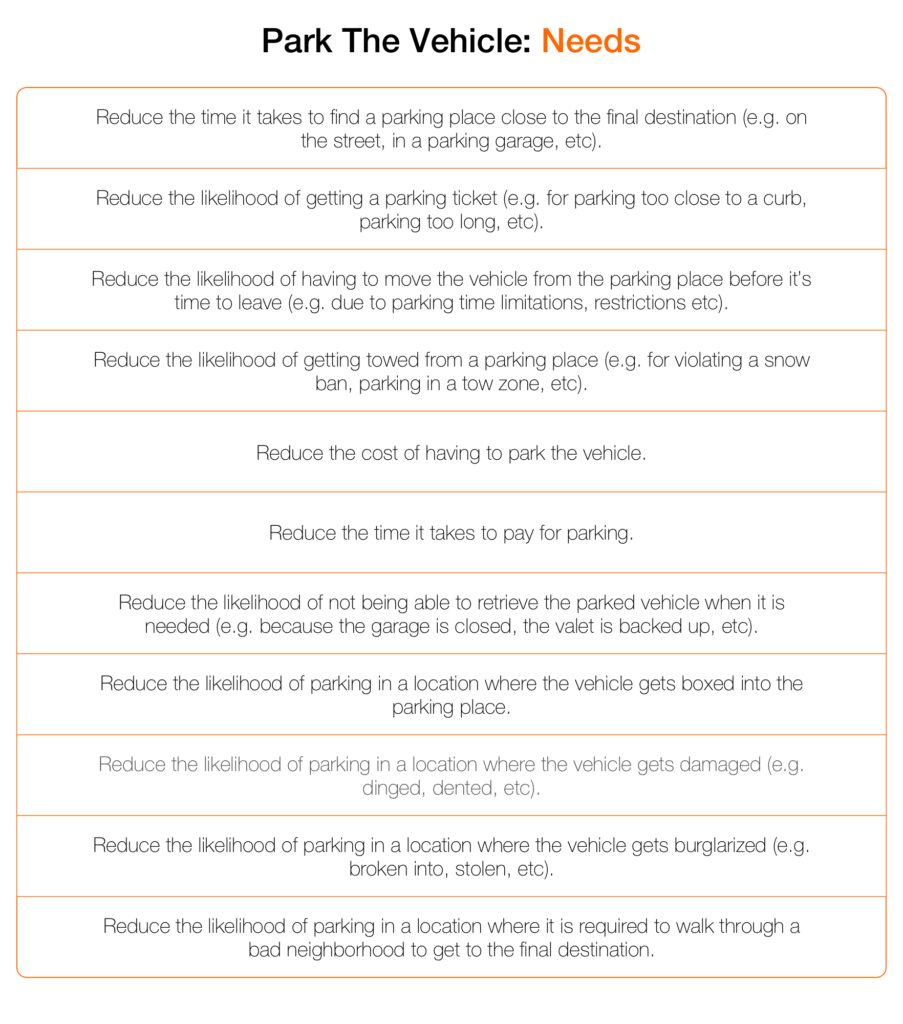
If a parking app can satisfy most or all those needs efficiently, they will be able to protect themselves from being overrun by a big company that comes in to do the job step. To do this, parking apps should first identify where competitors' weaknesses in the job step are (i.e. what needs do they fail to satisfy). Then, they should see if solving these unmet needs carries enough opportunity.
For example, Google Parking does reduce the time it takes to find a parking place close to the final destination, but it doesn't reduce the likelihood of parking in a location where the vehicle gets damaged. Solving this unmet need actually has lots of opportunity, as customers report low satisfaction for this need but rate it as highly important. So, a feature that guides users to parking spots where it is less likely to get the car dinged or dented could help apps stay ahead of Google in the parking job step.
Solving more needs of the parking job step quickly and accurately could allow you to have sustained success. It could also set you up for acquisition by a big company. For example, Waze served the need of "reduce the time it takes to determine if an alternate route should be taken to save time due to unexpected travel conditions" within the job step "reset the route as needed" so well that Google decided to purchase the map app for $1.2 billion in 2013.
Still, even if you do that one job step substantially better than the competition, it might not be enough. After all, customers will still have to hire other solutions to get the job done. That means you have to work on getting more steps in the job done.
Get More Job Steps Done
Limited time and resources may make it hard to compete with Google overall when it comes to reaching a destination on time, but keep in mind your options. After improving upon the parking job step, you have two of them, which are:
- Do more job steps. Waze, by crowdsourcing construction and traffic, is able to help drivers determine how much time to allow for atypical travel conditions, in addition to setting the route (note the company accomplished this before Google acquired it).
- Use existing assets to tackle other jobs. While working on parking, a company may have developed other technology or operational assets that can get steps in other jobs done. For example, Uber is using its assets to tackle the job "get something to eat" with UberEats. This job is adjacent to their primary focus.
It can be extremely daunting when a large company puts you in their sights. But, once you understand all of the unmet needs in all of the job steps of your job or find adjacent jobs you can tackle, you will have opportunities to stay alive.
Final Advice
Doing just one job step that in a larger job may not be sustainable. Your competition will likely threaten you from many angles--the other job steps in the job. But, remember there are three moves you can make to stay ahead:
- Look for ways to satisfy more needs in the job step so that you stay far enough ahead of all competition.
- Find ways to expand on the job steps you do so that you can get the whole job done faster and more accurately.
- Find adjacent jobs to which you can apply your existing assets.
These three steps can help you stay relevant over time, even if a Goliath is coming for you.
https://www.thrv.com/how-to-do-jtbd/market-sizing-with-jtbd
Posted by Jared Ranere View all Posts by Jared Ranere



